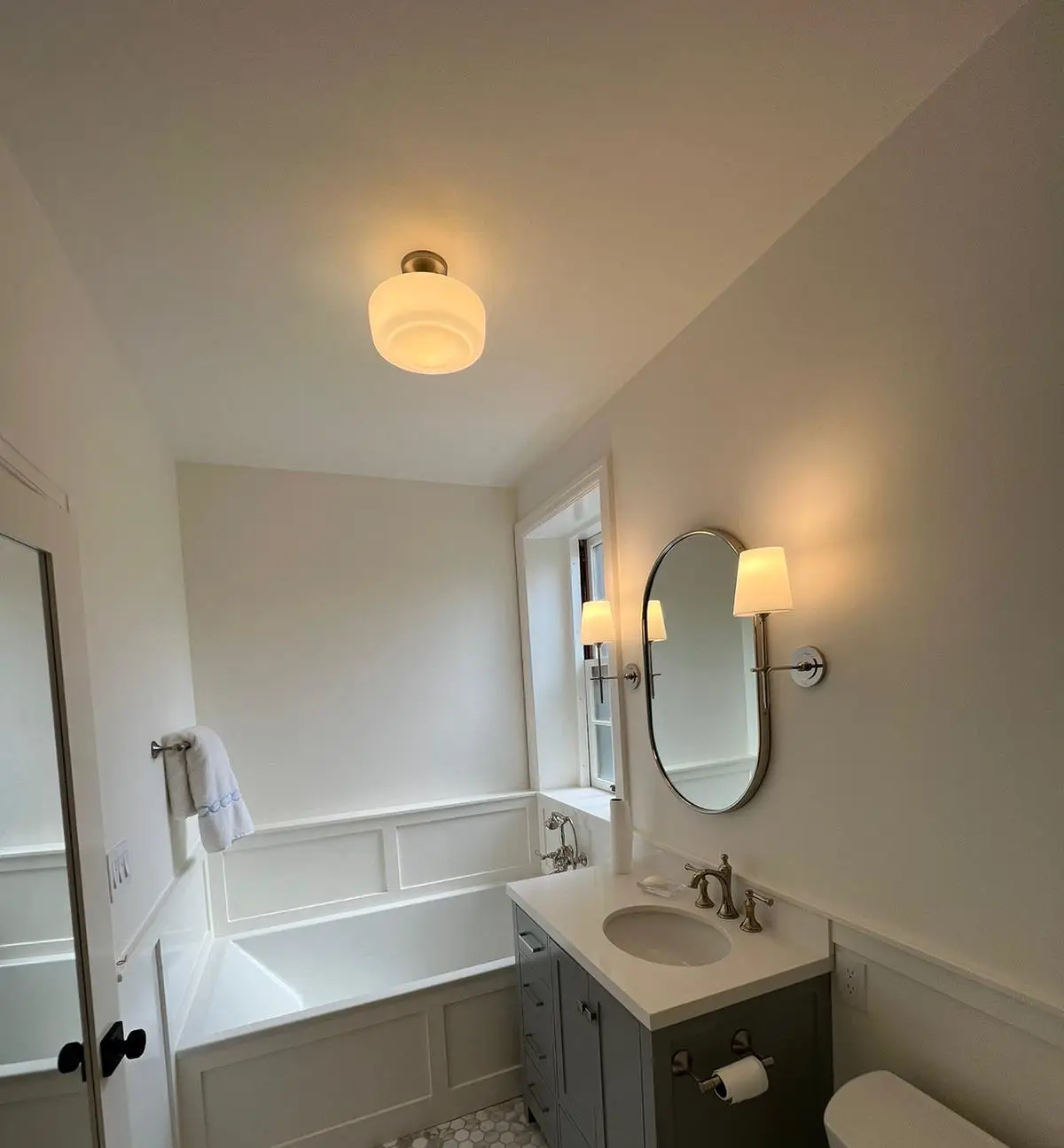Blogs

Bathroom Ceiling Paint Guide – Best Paint & Application Tips
The bathroom ceiling is often an overlooked surface, yet it's arguably one of the most challenged areas in your home. Constantly exposed to steam, humidity, and fluctuating temperatures, a standard ceiling paint can quickly succumb to drips, streaks, peeling, and the unsightly growth of mold and mildew. To ensure a fresh, clean, and healthy bathroom for years to come, understanding the best paint for a bathroom ceiling is paramount. It's about choosing formulations designed specifically to combat moisture and deliver a durable, stain-free finish.
Why bathroom ceilings need special paint
Bathroom ceilings face unique environmental stresses that demand specific paint characteristics.
High Humidity and Condensation: Showers and baths generate significant steam, leading to high humidity levels. This moisture rises and condenses on the coolest surface in the room – often the ceiling. Regular paints absorb this moisture, leading to:
Peeling and Blistering: The paint loses adhesion as it becomes saturated with water.
Streaking and Water Marks: Condensation drips can leave noticeable streaks and stains as they run down the ceiling.
Mold and Mildew Growth: The warm, damp environment of a bathroom ceiling provides an ideal breeding ground for mold and mildew. These fungi appear as black, green, or brown spots that are unsightly, can be difficult to remove, and may contribute to poor indoor air quality.
Lack of Air Circulation: Even with an exhaust fan, corners and areas farthest from the fan may experience stagnant, humid air, exacerbating moisture problems.
Splashes and Reside: While less common than on walls, splashes from showers or cleaning can still reach the ceiling, requiring a washable surface.
Standard interior paints lack the necessary moisture resistance and antimicrobial additives to withstand these conditions effectively, making them a poor choice for bathroom ceilings.
Paint type and sheen options
The right type of paint and its sheen level are crucial for a durable and aesthetically pleasing bathroom ceiling.
Paint Type:
Acrylic-Latex "Kitchen & Bath" Formulas: This is the gold standard for bathroom ceilings. These paints are specifically engineered with enhanced moisture resistance and often contain mildewcides (fungicides) to inhibit mold growth. They form a harder, more water-repellent film than standard latex paints.
Avoid: Traditional "flat" ceiling paints or standard interior latex paints that are not labeled for high-humidity areas.
Sheen Options:
Satin:
Recommendation: A highly recommended sheen for bathroom ceilings.
Pros: Offers a soft, subtle sheen that makes it durable, washable, and more resistant to moisture absorption than flat finishes. It reflects light gently, which can help brighten the room without being overly glossy.
Semi-Gloss:
Recommendation: A very durable and moisture-resistant option, particularly in bathrooms with extreme humidity.
Pros: Its harder, smoother surface is excellent at repelling water, inhibiting mold, and is highly scrubbable.
Cons: It has a noticeable shine and will highlight ceiling imperfections more than a satin or flat finish.
Matte/Flat:
Recommendation: Generally not recommended for bathroom ceilings.
Pros: Hides imperfections well.
Cons: Most porous sheen, meaning it absorbs moisture readily, making it highly susceptible to stains, streaks, peeling, and mold growth. It's also very difficult to clean without damaging the paint film.
Pro Tip: While flat is often preferred for ceilings to hide imperfections, in a bathroom, the moisture resistance of a satin or semi-gloss often outweighs the desire for a perfectly matte look. Many "Bathroom Ceiling" specific paints come in a "dead flat" or "ultra-flat" sheen, but are formulated with the durability of a higher sheen to hide imperfections and resist moisture.
Anti-mold and washable paints
These features are non-negotiable for bathroom ceiling paint.
Anti-Mold (Mildewcides):
High-quality bathroom paints come pre-mixed with mildewcides, which are chemical additives that actively inhibit the growth of mold and mildew on the paint film. This is your primary defense against those unsightly black spots.
Primer Option: For areas with a history of mold, consider using a mold-killing primer before painting, even if your paint contains mildewcides. This ensures you've killed any existing spores before encapsulating them.
Washable and Scrubbable:
Bathroom ceilings can develop water spots, streaks, or even minor mildew spots over time that need to be cleaned.
A paint with a satin or semi-gloss sheen, or a "kitchen & bath" formula, will be much more washable and scrubbable than a flat paint. This allows you to gently wipe down the ceiling without damaging the paint film, maintaining its clean appearance.
Color choices to brighten a bathroom
While white is a classic choice, other colors can also contribute to a bright, clean, and inviting bathroom.
Classic White:
Pros: Makes the bathroom feel larger, brighter, and cleaner. Reflects maximum light, making the space feel airy and expansive. It's timeless and versatile.
Consideration: Use a specific "bathroom white" or one with anti-mold properties to prevent unsightly black spots.
Light Neutrals (Off-Whites, Very Light Grays, Creams):
Pros: Offer a softer look than stark white, adding subtle warmth or coolness while retaining the brightness. They can harmonize with wall colors for a seamless flow.
Consideration: Ensure they are still light enough to reflect ample light.
Matching Walls (Less Common):
Pros: Painting the ceiling the same color as the walls can create a seamless, enveloping "box" effect, making the room feel taller.
Cons: If using a dark wall color, this can make a small bathroom feel much smaller and more cavernous. Requires excellent ventilation to prevent the darker ceiling from showing moisture issues.
Slightly Tinted Whites: A very pale tint of the wall color (e.g., 25% of the wall color's formula) can create a subtle, integrated look that is still bright but less stark than pure white.
Tip: Lighter colors generally perform better on bathroom ceilings as they reflect light and help make the space feel cleaner and larger.
Application tips and ventilation best practices
Proper application and ongoing ventilation are critical for a long-lasting, stain-free bathroom ceiling.
Application Tips:
Prep is King: Ensure the ceiling is thoroughly clean, dry, and free of any old peeling paint or mold. Scrape loose paint, sand smooth, and wipe down.
Mold-Killing Primer: If previous mold was an issue, use a mold-killing primer first.
Ventilation During Painting: Keep windows open and the exhaust fan running (or use portable fans) to ensure good air circulation while painting. This helps with drying and reduces fumes.
Roller: Use a high-quality roller with a medium nap (3/8-inch) for good coverage. An extension pole is essential for comfort and even application.
Thin Coats: Apply 2 thin, even coats of paint, allowing ample drying time between coats according to the manufacturer's instructions. This reduces drips and ensures proper adhesion and cure.
Work Methodically: Paint in sections, maintaining a wet edge to avoid lap marks.
Ventilation Best Practices (Ongoing Maintenance):
Use Exhaust Fan: Always run the bathroom exhaust fan during showers/baths and for at least 15-20 minutes after to effectively remove humid air.
Clean Fan: Periodically clean your exhaust fan's grille and motor to ensure it operates efficiently.
Open Windows/Doors: If weather permits, open a window or leave the bathroom door ajar to allow moisture to escape, especially after a shower.
Wipe Down Surfaces: Occasionally wipe down the ceiling with a damp cloth to remove any accumulated moisture or residue, especially in areas prone to condensation.
Choosing the best paint for your bathroom ceiling is an investment in your home's health and appearance. By prioritizing moisture resistance, anti-mold properties, and proper application, you can ensure your bathroom remains a fresh, clean, and stain-free oasis for years to come. For a truly professional finish that withstands the unique challenges of your bathroom, Masterpiece Painter offers expert solutions and meticulous craftsmanship.
Ready to protect and beautify your bathroom ceiling? Contact Masterpiece Painter today for a consultation and bring your vision to life!
About Masterpiece Painter
For over 17 years Masterpiece Painter, has been serving communities all around New England. Let us help you make your wishes come true by turning your property into a Masterpiece
Get a Quote

© copyright 2023 All Rights Reserved.



